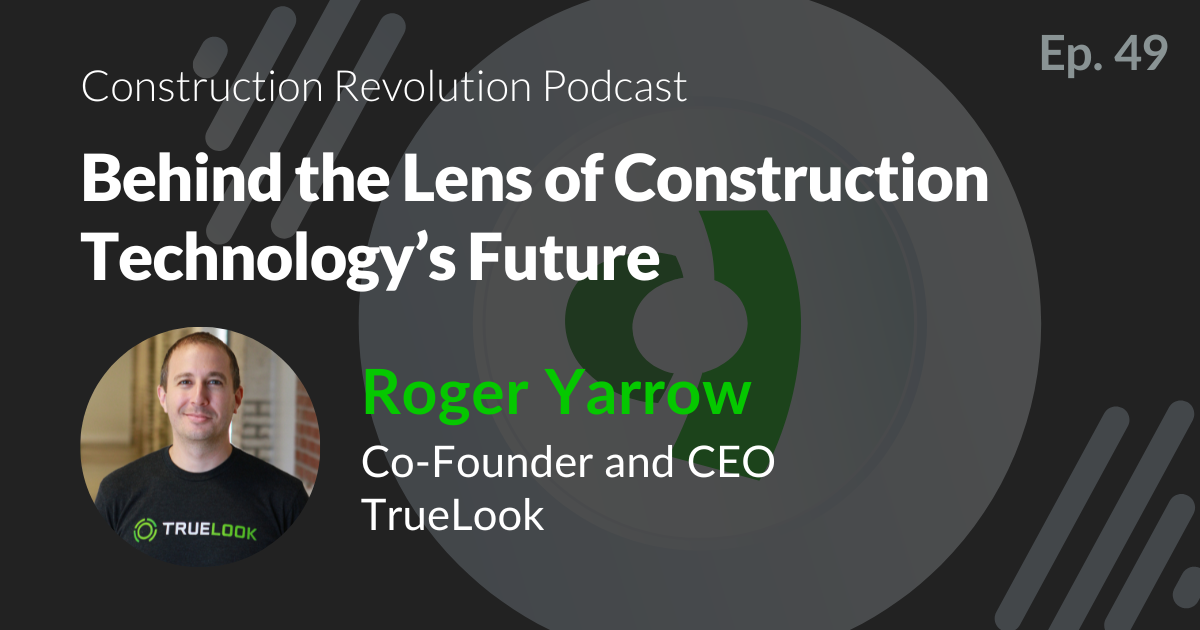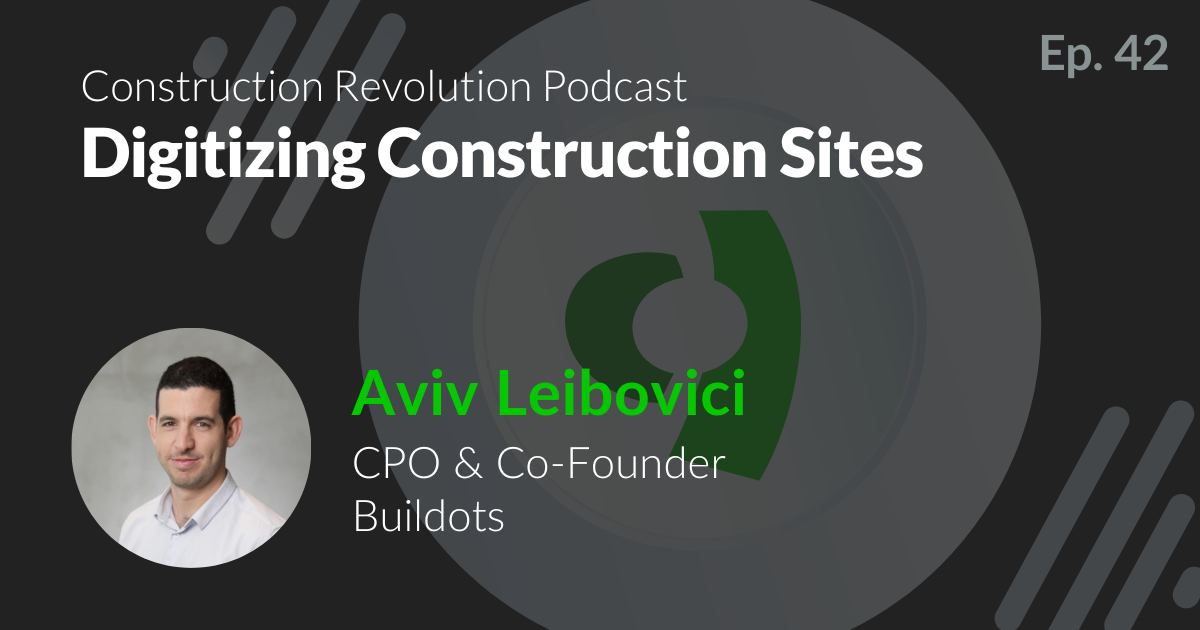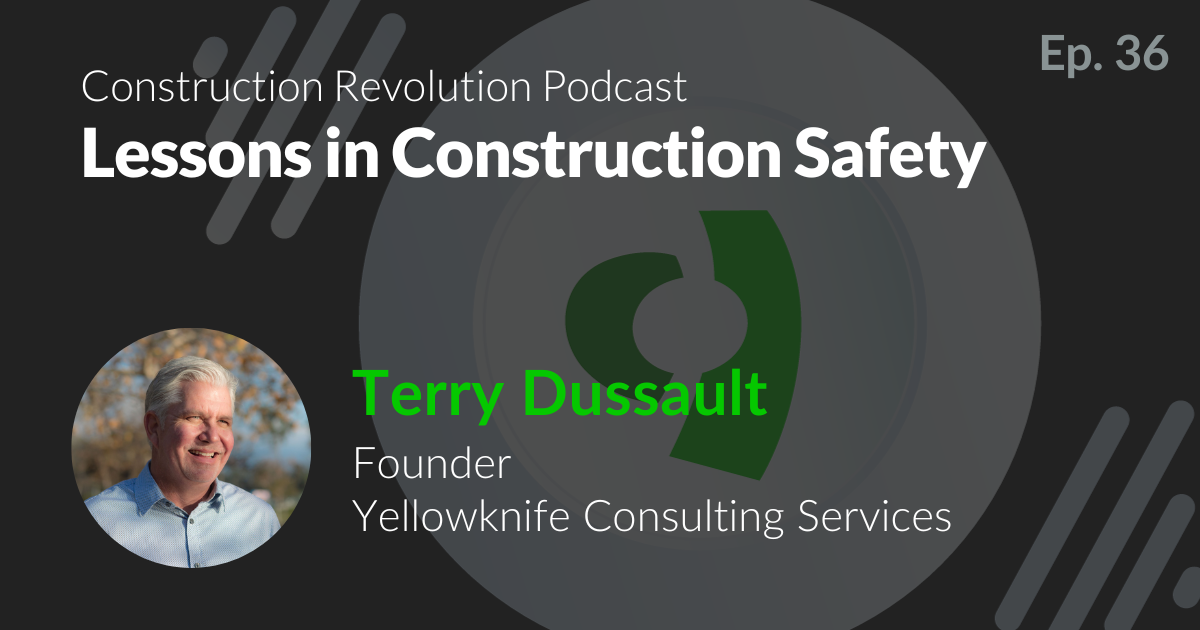
Episode 19 |
March 24, 2022
Augmenting Construction Workers’ Performance Through Robotics
In This Episode
In this episode of the Construction Revolution podcast, we sit down with Kristi Martindale, Chief Product and Marketing Officer for Sarcos Technology and Robotics Corporation. She discusses how Sarcos Robotics manufactures robotic solutions for industrial construction applications. Kristi explains two of their flagship products, the Guardian XO, a full body exoskeleton designed to increase worker capability and reduce the risk of occupational injuries, and the Guardian XT, which takes the upper body of the XO and turns it into a teleoperated robot that can bring human dexterity to hazardous environments. Tune in to find out how exoskeletons and human operated robots can improve safety and efficiency on your jobsite.

Host
Ian Wright
Content Marketing Manager, Giatec Scientific Inc.

Guest
Kristi Martindale
Chief Product and Marketing Officer, Sarcos Technology and Robotics Corporation
Podcast Transcript
Ian Wright:
Hello, and welcome to the Construction Revolution Podcast, where we explore the trends, technologies, organizations, and people that are changing what the construction industry will look like tomorrow. I’m Ian Wright, and today I’m joined by Kristi Martindale, Executive Vice President and Chief Product and Marketing Officer at Sarcos Robotics. Sarcos Robotics manufactures robotic solutions for industrial construction and defense applications. They’re building exoskeletons, real sci-fi stuff, like the Guardian XO, a full body exoskeleton designed to increase worker capability and reduce the risk of occupational injuries. The Guardian XT takes the upper body of the XO and turns it into a teleoperated robot that can bring human dexterity to hazardous environments. Seriously, go check out their website. There’s a ton of really cool stuff on there.
Kristi, welcome to the show.
Kristi Martindale:
Thank you for having me, Ian. It’s a pleasure to be here.
Ian Wright:
So, maybe to start, can you give us a bit of a history of the company? What was the vision when it was founded back in 1983? Were exoskeleton on the roadmap all the way back then?
Kristi Martindale:
Well, in early 1983, it was originally spin out of the University of Utah. Its focus, at that time, was really about finding kinematic equivalent types of robotic systems. So, really looking at the biomechanics of systems and how that might be applied in a robotics sense. Really, the vision we’re exploring today came about in 2015, when there was a management buyout of the company, Ben Wolff and Fraser Smith bought the company. And at that time is when we really took all of the learnings over the many years of developing robotic systems and focused all of that energy on developing systems with robots that would really be applicable in industrial environments with the intent and the mission of saving lives and preventing injuries.
Ian Wright:
So, can you tell us a bit more about the products that you’re offering?
Kristi Martindale:
Absolutely. So, in our product portfolio, we have two flagship products that are applicable to the construction sector, and those are the Guardian XO, the one you referenced in your introduction, that is a full bodied powered exoskeleton suit. It has the capability of lifting up to 200 pounds and all of the weight that the robot will lift goes through the robot through the floor. So, the Guardian XO allows the human to operate with little impact to the human’s body. The human doesn’t feel the weight of the item or of the robot itself. So, we call that 100% load relief, so that the body of the operator is not impacted at all. It has hot swappable batteries, which allows it to effectively operate continuously over a duration of a work shift. So, there’s three batteries in the back of the exoskeleton and they’re hot swappable. So, you can swap one out when it’s running low and put a new one in, and continue to do your work. And the Guardian XO was designed to work in those unstructured environments that you typically find in a construction type of environment.
So, the other item we have, the other flagship product, is the Guardian XT. And as you noted, it is the upper portion of the Guardian XO, and we made it teleoperated, meaning that you can operate it from a distance, so you don’t have to be in the robot to operate it. And what it’s capable of doing, in addition to lifting the 200 pounds, similar to the Guardian XO, it also can be mounted onto any base. So, if you think about the types of tools and equipment in a construction type of environment, where you have boom trucks, or you have lifts, you have scissor lifts, it allows you to put the Guardian XT into those scenarios so that the at height work that is very risky for humans to do, it allows the humans to do so in a more safe manner.
Ian Wright:
That’s really interesting. So, you’re talking about reducing liability through robotic augmentation. I’m curious, with the XO, is there a lot of customization that goes into the wearer of it? Can you just step into it, or do you need to be measured? Does it need to be adjusted?
Kristi Martindale:
So, the Guardian XO, the current version is 5’9″ to 6’2″ is the height, but the commercial one that we’re launching at the end of this year will support anyone from the height of 5′ to the height of 6’2″. What we really see both the Guardian XO and the Guardian XT being capable of doing is equalizing the workforce. So, if you can imagine I’m small, I’m 5’1″, and there’s no way I could be lifting the type of equipment and moving it through a construction site or even my house. And what we see is this normalizing of the workforce. So, somebody like me could, technically, work in a construction environment and do that heavy lifting that typically is reserved for larger people with a better lift capacity, if you will.
Ian Wright:
So, with a wave of retirement, that’s coming from the baby boomer generation, there’s been a lot of things spilled over the impending skills gap. That’s going to come as a result. So, it sounds like, do you see your solutions as partially addressing this?
Kristi Martindale:
Absolutely. In the studies we’ve done, over 21% of the workers are over the age of 55. So, a lot of industries, they’re aging out of the workforce, and we do see it addressing it in two ways. One, the Guardian XO or the Guardian XT will allow people to work in the jobs for a longer period of time because there’s less injuries, less strain to their body. So, it’s allowing, if somebody wants to be in that role for a longer period of time, they’re able to. It also allows it to appeal to the younger generation. Right now, younger generation is really not interested in going into these trades that are very fatiguing and difficult types of environments to work in. But when you tell them they get to be a robot pilot or robot operator that changes the game a little bit, right? Everybody loves a robot. And so it allows them to see there’s the opportunity here that is not as taxing and will allow me to learn some new skills. And it is definitely helping to level that playing field and open the aperture of the workforce of people that would come in.
Ian Wright:
What’s the learning curve like on the Guardian XO? Can I just get in, and within a few minutes, I’m lifting 200 pounds, or do I need some training, some time to get used to it?
Kristi Martindale:
So, the Guardian XO is kinematic equivalent. So, what we mean by that is it effectively acts as an extension of you, as a human. So, when you move your arm, the robot is moving along with you. So, you’re not pushing or pulling. There’s about 125 or more sensors in the Guardian XO. And the frame, the word we use is it’s a get out of the way controls work throughout the Guardian XO. And what that means is the robot’s job is to stay out of your way as a human. So, as you move your arm, it’s moving within a hundred milliseconds. It’s very, very fast. So, it’s very easy to learn just because it’s operating, we call it augmenting the human, it’s operating as an extension of you as a person. That said, what you would have, it’s a piece of equipment, right? And so for safety and those types of things, you would have a training period that would be similar to, say, operating in a forklift in the industrial environment.
Ian Wright:
Sure. That makes sense. Now, you’re working in industrial environments, construction, the defense sector. I’m curious about the biggest differences that you’re seeing between them, in terms of the applications that your products are seeing, or maybe even the adoption rates.
Kristi Martindale:
Absolutely. So, the work is very similar. So, in defense and industrial sectors, if you think about the work that’s being done, it’s consistent in terms of what we’re focusing on. So, we’re focusing on things like the last mile of moving types of equipment. So, logistics, moving big, heavy equipment. There’s a lot of logistics and building in the defense sector as well as, obviously, the industrial commercial sector. And there’s a lot of repairs in both sectors. So, if you think about repair, maintenance, and inspection, that crosses through both areas. And so if you look at some of types of activities that a Guardian XO or a Guardian XT could perform, constructing and deconstructing scaffolding. A lot of scaffolding work is not only laborious, but it can be dangerous, things dropping from above down to another level. And again, the just general logistics of shipping and receiving, moving pallets or moving boxes of equipment or tools that are coming to a site. Those five gallon, if you think about those five gallon paint cans that are in construction and there’s other kinds of liquids and other areas, and those weigh somewhere around 70 pounds, depending on the liquid that’s inside of it. So, lots of logistics, lots of moving of materials and equipment in both sectors.
Ian Wright:
So, it sounds like we’re not talking about very, necessarily, highly specialized tasks, but tasks that come with a certain degree of risk and that have some injury associated with some strain associated with them. I’m curious about, just kind of extend onto the construction industry specifically, where do you think you see the biggest benefits `for users?
Kristi Martindale:
So, in the construction industry, specifically, it’s really around the at height work for the Guardian XT. So, the at height work is the fourth leading cause of injuries in the workspace. Many of those heights, if they’re above 30 feet, can cause death. So, people die from those injuries at falling at height. And the type of work you can do with the Guardian XT, since it’s teleoperated, you can use off the shelf tools. There’s what we call an end effector, which is essentially the robot’s hand, it allows it to use and pick up off the shelf tools. So, you can use things like power tools at height, custom assembly tools, welding and cutting equipment, and you can do so at a distance. So, the person can be on the ground safe out of the hazard environment and perform this dextrous task. So, when you mentioned earlier, skilled work, many of these tasks do require skill labor, right? If you think about welding, a welder is a skilled labor. And some of the environments and ways they have to get in there to do the welding, you have to be a contortionist to get in there and do the weld. And so this would allow that skilled worker to be, again, more distant and remote, and perform the task that would be at height, and would keep them out of harm’s way.
Ian Wright:
Makes sense. Now, I understand Sarcos was recently cited in an article on the biggest trends of 2022. I’m curious, why do you think robotic systems like yours would be trending this year?
Kristi Martindale:
One of the biggest challenges, I think, is what you raised earlier, in terms of the labor shortage, there’s just simply not enough workers for people to do the jobs they need to do. Construction is, specifically, one of the highest hit industries. There was 2 million jobs lost. They had, at the beginning of COVID, 430,000 job openings in the US for construction workers. As you noted, there are many people aging out. So, 21% of that workforce is over 55, they’re retiring. And so being able to help augment the workers, the staff, the teams that you have out in the field is one of those critical things. Everyone’s trying to figure out how to do more work and meet their productivity targets with the teams that they have. And I think robots are one of those ways they’re able to gain efficiencies and do that work in a more effective manner while also keeping their existing teams more safe.
Ian Wright:
Great. Can we talk about price? Because I think anyone business minded is going to be wondering what’s the ROI. How do you measure it?
Kristi Martindale:
So, there’s a number ways we measure ROI. Couple ways, obviously, the more straightforward way is we look at the deployment of either the Guardian XO or the Guardian XT, the equivalent of a fully burden, full-time employee. So, we deploy our robots on a robot as a service model, which means that you can lease the robot on a one, two, or three year path. And it will always show up to work. We’ll do all the service, the maintenance, all of the software upgrades. But then when you look at other intangible, the cost of injuries on the job. For a shoulder injury, as an example, the average payout in worker’s compensation is about $46,000. They have to pay a wage premium to their workers anywhere from 10% to 30% for any workers working at height.
Kristi Martindale:
And then you look at the cost of workers’ comp. There’s a huge cost of workers’ comp anytime someone gets hurt. When someone’s hurt on the job, there’s a productivity impact, and often they have to shut down the job to do an assessment of what happened. And that could be anywhere from an hour to two days, depending on what the injury was, so that they can make sure they understand and they resolve that issue. And then when you look at even the cost of fatigue, there’s estimates that it’s somewhere around $136 billion in lost production, just due to people being tired. There’s only so long the human body can do a laborious task, especially if you think about some of these extreme environments in which they’re working in, the heat or the extreme cold. So, we see all of those factors as ways companies look at modeling the ROI for deploying these types of systems.
Ian Wright:
Sure. Yeah. I think it makes a lot of sense to focus on the risks that you’re avoiding and the reduction of liability. The point about fatigue is a very good one too. So, I’m curious about, given all this, what’s the long term vision or the goal? Is it to have Guardians in every job site? Are they replacing traditional equipment? Are they supplementing, or what’s the vision of 10, 20, 30 years from now?
Kristi Martindale:
Wow, that’s a long time in robot years. Can we get to end of this year when we’re commercially launching our systems up? But absolutely, we’re not looking to- Really, there’s nothing in the market right now that is doing what we’re trying to solve for, really working in those unstructured environments, being able to lift up to 200 pounds with a single worker. That’s the other thing. You have OSHA guidelines where you should only lift up to 35 pounds. That’s the guidelines. If you even think about that from an ROI perspective, a single person can lift up to 200 pounds without having to do a team lift and bringing other people in.
As far as what’s out in the construction world, I’ve been out many, many sites, obviously there’s lots of different tools. You have forklifts, you have boom cranes, you have scissor lifts. What I found is the construction world is so extraordinarily creative in that if something doesn’t exist to do the job, they will figure out how to make something else do the job. That doesn’t always mean it’s safe. It just means they’re going to figure out how to get that job done. And so everything from moving rebar to using forklifts, to maybe lift something that it’s not intended to do. And so, oftentimes, this is where those injuries come in. So, we really just see it as another tool in the tool chest that’s solving those problems that the existing tools that have been available for many, many years aren’t able to solve for narrative reasons.
Ian Wright:
Great. I have one final question. This is a question I’m trying to ask every guest on the Construction Revolution Podcast. Kristi, what do you think is the biggest driver of revolution in construction today?
Kristi Martindale:
I think it’s the same as many, many other industries in that this need to continually do more with less and the impact of workers moving out of the industry, retiring out. And I love to tell this story, went on a job site once to do an interview with a customer, and he was thrilled. His comment exactly was, “I’m so excited to have someone come to me and talk about innovation and that’s not showing me an iPad.” So, they’re really hungry for something that will really transform and help move the industry forward. They’re one of the few industries that haven’t been able to take advantage as much of technology evolution and technology boom, just because of the nature of the work. So, they’re really excited about the potential of bringing solutions in that will really revolutionize how work is done in the industry.
Ian Wright:
Kristi Martindale from Sarcos Robotics, thanks very much for joining us today.
Kristi Martindale:
Thank you. Appreciate your time.
Other Related Episodes
Episode 49 |
September 12, 2024
Behind the Lens of Construction Technology’s Future
In this episode of The Construction Revolution Podcast, Steven Rossi sits down with Roger Yarrow, CEO and Co-Founder of TrueLook Construction Cameras. With over 25 years of experience in technology and leadership roles at industry giants like IBM and Xerox, Roger is at the forefront of innovation in jobsite visibility solutions. Tune in as Roger shares the story of TrueLook, discusses the latest trends in construction technology, and reveals how advanced camera systems and comprehensive surveillance solutions are transforming jobsite management. Whether you're interested in theft prevention, time-lapse documentation, or integrating cutting-edge technology into your projects, this episode offers valuable insights into the future of construction.
PLAY
Episode 42 |
May 16, 2024
In this episode of The Construction Revolution Podcast, we are joined by Aviv Leibovici, CPO & Co-Founder of Buildots. Aviv brings a mix of technological innovation, and visionary entrepreneurship to the construction industry. Join host Steven Rossi as he delves into Aviv's remarkable journey from an esteemed educational background in computer science to the groundbreaking establishment of Buildots. Discover how Aviv and his team are revolutionizing the construction world with AI-driven technology that transforms construction sites into digitized environments for real-time tracking and decision-making. This episode offers a deep dive into how Buildots' platform is influencing major construction projects worldwide, enhancing efficiency, and redefining traditional construction methodologies. Don't miss this episode to learn about the fusion of AI, computer vision, and construction management through the lens of Aviv Leibovici's unique experience and vision. This conversation is a treasure trove of insights for anyone fascinated by the intersection of technology and construction, and it underscores why Aviv's leadership at Buildots is pivotal for the future of the construction industry.
PLAY
Episode 36 |
January 11, 2024
Lessons in Construction Safety
In this episode of The Construction Revolution Podcast, we sit down with Terry Dussault, Founder of Yellowknife Consulting Services. With over 25 years as a corporate environmental health and safety professional, Terry has become Southern California's foremost safety expert. We will focus on the importance of safety and compliance on jobsites. Tune in to learn about the best practices that you and your team can implement to make your jobsites safer for everyone. Discover how Terry's expertise in various safety regulations has shaped his career and influenced the construction landscape.
PLAY
Want to Be a Guest Speaker, Sponsor, or Just Have a Question for Us? Fill In the Form!




